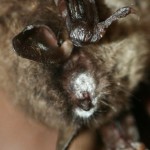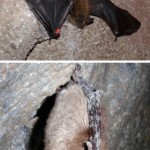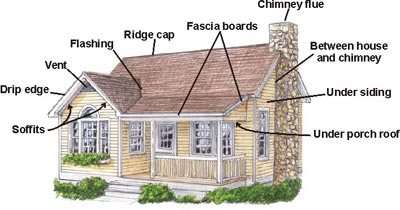Minnesota Bat Removal
The days are getting cooler, the nights are getting longer, and another Minnesota winter is just around the corner. It’s also one of one of the best times of the year to walk around your house and look for any gaps or openings where bats can enter your house . For some people bats don’t present a problem but for others… not so much! Some people are just totally creeped out by them, especially when they become unwanted guests in an attic, chimney or inside your home.
Bats In Your Attic? Say It Isn’t So!
Despite their creepy reputation, bats, provide excellent insect control and are an integral part of our neighborhoods. Bats inside our homes; however, can be a problem.
Granted, with their rat-like faces comprised of large, bulging eyes, pointed snouts, sharp teeth, and alien-like ears won’t win any beauty contests, but the advantages of having them around far outweigh any problems you might have with them. In Minnesota alone the economic benefits of insect-eating bats to agriculture are calculated to be $1.4 billion.

A brown bat displays the white nose characteristic of White Nose Syndrome, which has been detected for the first time in Minnesota.
Minnesota has seven bat species. Two of them — the big brown bat and the little brown myotis — are considered species of special concern in Minnesota, meaning they are already threatened. A fungus that can cause a devastating disease in bats has been discovered in Minnesota for the first time.
The fungus that is linked to white-nose syndrome has been found at Forestville/Mystery Cave State Park in southeastern Minnesota and at Soudan Underground Mine State Park on the Iron Range, according to the Minnesota Department of Natural Resources. (Mystery Cave has about 2,300 bats. Soudan Underground Mine has 10,000 to 15,000 bats.)
Since white-nose syndrome was first discovered about six years ago in New York, the disease has killed nearly 6 million bats in the eastern North America.
The fungus damages a bat’s wings and can lead to unusual behaviors. Dehydration caused by the fungus can send bats on a search for something to drink during cold weather.
That is also going to use up their stored fat reserves so then they may be actually starving and may be trying to fly outside to find insects during the winter.
Minnesota is home to at least 50,000 hibernating bats that pollinate plants and help control insects that feed on farm crops and trees in Minnesota’s forests. A decline in bat populations could lead to problems with pest control in the state.
Officials said the good news is that the fungus has only been found in four bats — three little brown bats and one northern long-eared bat. It wasn’t detected on any cave walls.
Bat Removal
Bat folklore goes back many centuries. Bats seem to have been given an undeservedly bad reputation. In truth, bats are intelligent animals, important to ecosystem and of considerable benefit to people. And the last thing they want to do is get tangled up in your hair. Yet no other wildlife species elicit such a range of reactions and emotions as bats.
Perhaps, the most important place to start is what you can’t do. Bats are a protected species. It is illegal for anyone, including animal control officers and professional wildlife removal specialists to kill bats. Terminal traps and poisonous bait traps should never be used.
That is when it’s time to call a wild animal control specialist who can remove the bats safely and humanely and more important, after eviction, “bat proof” the home to prevent later reentry. Eviction and exclusion are the only safe, permanent remedies.
Close inspection of entry points usually will reveal brown stains caused by body oils where the bats squeeze in and out and possibly a few mouse-like droppings adhering to the building just below. Bats must eat and drink daily. When they emerge at dusk to feed, watch your home to see where they leave. Then closer inspection by a wild life removal specialist will reveal the holes or cracks providing access to a home.
Just like birds, raccoons and squirrels, bats often try to make their homes within walls, chimneys and other hard-to-reach locations. In many cases, these animals will enter the chimney but won’t be able to exit, eventually dying.
Common access routes are:
- Under the eaves
- Behind a chimney or loose board
- Beneath a roof’s ridge cap
- Inside an opening made by squirrels or birds
- Loose-fitting screen doors
Once exits have been located, the bats can be excluded. This should not be done when flightless young may be present which is usually in June and July. Excluding the parents will starve the young and create an unpleasant odor problem from the decaying carcasses. Most bats leave their roosts starting in August and into the fall.
Wild life relocation is a delicate process, best left to the professionals that know what they are doing. Applying humane methods to solving bat conflicts allows us to remove them without injury and allows the homeowner to enjoy the many benefits of these amazing animals- outside of your home.
Bat removal is probably the most intricate and difficult task that a Minnesota Wild Life Management Expert deals with on a regular basis. Their sense of direction is impeccable, so even if a homeowner successfully found a way to trap a bat colony and drove them to a place far away, bats have been known to fly back to their home site up to 500 miles away in a few short days or weeks. If exclusionary measures are not implemented, it is highly likely the bats will return.
Many homeowners who recognize the value of having bats at work for insect control will opt to put up a bat house at the time of eviction, hoping the bats will find and use it, or occupy it on return the next spring.






